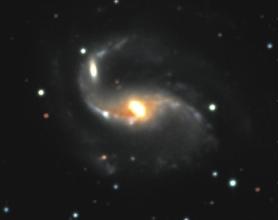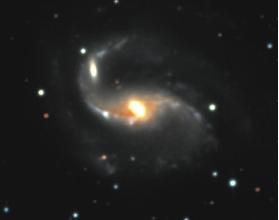







| BOOKS | F. A. Q. | ARTICLES | TALKS | ABOUT KEN | DONATE | BEYOND OUR KEN |
|---|
By Ken Croswell
May 14, 2007

Image courtesy of Barry Madore.
Two objects discovered in Capricornus during the 1800s are a
pair of colliding galaxies, say astronomers in California and
Spain. Furthermore, the collision probably spawned much of the
larger galaxy's splendor.
NGC 6907 is a beautiful barred spiral, with one spiral arm brighter than the other. During the twentieth century, astronomers considered another object near it--NGC 6908, located 40 arcseconds, or 1/90 of a degree, away--merely a bright spot in the barred spiral's brighter arm.
In 2004, however, astronomers Jason Surace, David Sanders, and Joseph Mazzarella reported that "NGC 6908 is actually a small spiral galaxy superimposed on the northeast arm of NGC 6907." These astronomers examined near-infrared images, which captured light slightly redder than the human eye can see and thereby enhanced the contrast between the two galaxies. That's because the companion galaxy is redder than the barred spiral's arms, which are blue.
Now Barry Madore and Ian Thompson of the Carnegie Observatories in Pasadena, California; Armando Gil de Paz of Complutense University in Madrid; and Olga Pevunova at the California Institute of Technology have discovered that the companion is an S0 galaxy colliding with the barred spiral.
An S0 ("S zero"), or lenticular, galaxy is a cross between a spiral galaxy and an elliptical galaxy. Like a spiral, an S0 galaxy has a disk of stars; but like an elliptical, an S0 galaxy lacks spiral arms and bars. Such galaxies usually reside in galaxy clusters, where other galaxies and the cluster's intergalactic medium may have stripped them of most of their gas.
"It seemed to me that this was not a random alignment," says Madore, "because it looked like the companion was either an S0 galaxy or an elliptical galaxy. Now those are not field objects; they're usually in clusters. So if the companion had been something along the line of sight [between Earth and the barred spiral], there should have been other S0 galaxies and ellipticals around--and there weren't."
 The image here shows NGC 6907's brighter arm to the upper
left. The companion galaxy, NGC 6908, appears in that arm and
oriented nearly north-south. (In the image, north is up and east
is to the left.)
The image here shows NGC 6907's brighter arm to the upper
left. The companion galaxy, NGC 6908, appears in that arm and
oriented nearly north-south. (In the image, north is up and east
is to the left.)
"It turns out that when I made the initial determination, Ian Thompson was down at the Baade telescope [in Chile]," says Madore. "I just called him up and asked him if he could take ten minutes and give this a shot."
The observations showed that the two galaxies have the same redshift--about 3,100 kilometers per second--and thus the same distance from Earth: 140 million light-years.
Debris extends from the main galaxy, debris that Madore and his colleagues say is evidence of an earlier phase of this merger event during which material was ripped out of the companion galaxy and left to orbit the main galaxy. In addition, the companion has triggered the birth of new stars in the barred spiral's brighter arm. Thus, that arm appears brighter not only because the companion contributes light but also because it's stimulating starbirth there.
The barred spiral may even owe its dramatic bar to the companion. "A lot of the grand-design spirals have a companion out there--either at the ends of the arms or, in this case, right in the arms," Madore says. "I think these companions are major contributors to a lot of the spiral structure that we see."
The classic example is the Whirlpool Galaxy, M51. Its companion has likely whipped up the intense spiral structure that gives the galaxy its name.
Moreover, NGC 6907 resembles the asymmetric barred spiral galaxy NGC 1097 in Fornax, whose elliptical companion intensifies star formation in its brighter arm.
Madore and his colleagues will publish their discovery in the August 2007 issue of The Astronomical Journal.
Ken Croswell is an astronomer and the author of a book about cosmology, The Universe at Midnight, and a book about the Milky Way, The Alchemy of the Heavens. He is also the author of Magnificent Universe.
"The Universe at Midnight is vastly entertaining and enjoyable, as well as informative."--Sir Patrick Moore, New Scientist. See all reviews of The Universe at Midnight here.
"Ken Croswell's The Alchemy of the Heavens is one of the very best popular astronomy books in decades."--Keay Davidson, San Francisco Examiner. See all reviews of The Alchemy of the Heavens here.
"Magnificent Universe by Ken Croswell is elegant and eloquent."--Kathy Sawyer, Washington Post. See all reviews of Magnificent Universe here.
| BOOKS | F. A. Q. | ARTICLES | TALKS | ABOUT KEN | DONATE | BEYOND OUR KEN |
|---|